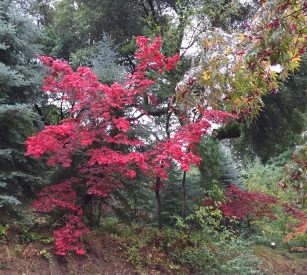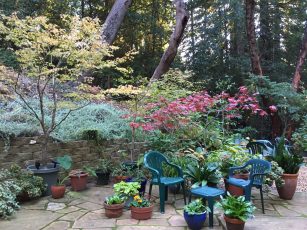The beginning of fall really started for me with those drenching October rains. Night time comes early now as daylight savings time ended last Sunday. Our fall color foliage trees and shrubs are starting to turn color. Will they be as vivid this year? Although we don?t get as much fall color as other areas we enjoy what we have just as much. Besides we don’t get snow on Halloween. Enjoy these cool nights and warm days. That?s the combination that brings on the best fall colors.

The vivid colors in a leaf are always there. They are just masked by the green chlorophyll which is busy making food by photosynthesis while the sun shines.
Come autumn, shorter days and cooler temperatures cause the trees to switch into energy-storage mode and their leaves stop producing chlorophyll. For the few weeks before the leave fall to the ground, they are colored only by their natural pigments. It’s these colors – red and purple anthocyanins, yellow and orange carotenoids – that make fall foliage so glorious, sometimes anyway.
Weather conditions play a major part in fall color. Some years the show is more dramatic than others. The best conditions for intense leaf color to develop are dry sunny days followed by cool, but not freezing, nights.

A warm, wet autumn will almost surely result in less-than-spectacular foliage because the process of chlorophyll loss will be less consistent. Freezing temperature meanwhile can cause leaves to drop suddenly denying the opportunity to enter a slow, colorful dormancy.
Which plants put on the best show in our area? Here are some of my favorites.
California native Western redbud turns yellow or red in the fall if conditions allow. This plant is truly a four-season plant starting in spring with magenta flowers, then leafing out with apple green heart shaped leaves. Colorful seed pods give way to fall color. This small native tree or large shrub does well as a patio tree in gardens with good drainage.
Other California native plants like Western dogwood, Spicebush and Western azalea turn yellow, red or gold in the fall. A native vine that lights up with the onset of autumn is Rogers Red California grape. If you have an arbor, wall or fence that needs covering quickly this is your plant. The green and gray leaves are transformed in autumn into great draperies of rich, scarlet red leaves with clusters of summer fruit turning all shades of purple.

Trees and shrubs that also provide fall color include Eastern dogwood, Chinese flame tree, Ginkgo, Idaho locust, Chinese Tallow, Chinese pistache, crape myrtle, smokebush, witch hazel, all maples, liquidambar, katsura, Eastern redbud, sumac, crabapple, goldenrain, locust, oak leaf hydrangea and barberries.
Edibles that turn color in the fall include blueberries, pomegranate and persimmons.
Light up your garden as the light fades and the days shorten. Now through late fall is a good time to shop for plants that change colors because you can see in person just what shade of crimson, orange, scarlet or gold they will be.
